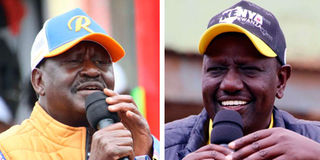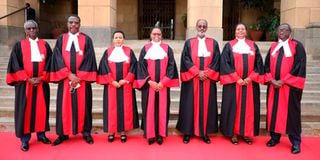How Raila, Ruto presidential election petition is likely to be framed

Azimio la Umoja leader Raila Odinga and Deputy President William Ruto.
The presidential election petition is likely to take a three-pronged strategy seeking to cast doubts about the figures, the vote-tallying, verification and results declaration.
The looming Supreme Court battle over the validity of Dr William Ruto’s election as President is mirroring the 2017 presidential petition in which the main dispute revolved around the electoral process rather than the final tally.
Dr Ruto’s main challenger, Mr Raila Odinga, has cited the split in the Independent Electoral and Boundaries Commission (IEBC) after four commissioners publicly disowned the results declared by the chairman, Mr Wafula Chebukati, among the grounds to dispute the outcome of the presidential vote.
“The figures announced by Mr Chebukati are null and void and must be quashed by a court of law. In our view, there is neither a legally and validly declared winner nor a President-elect,” Mr Odinga, the Azimio La Umoja One Kenya Coalition presidential candidate, has protested.
Besides the protests about the opaqueness of the vote tallying and verification process amplified by IEBC vice chair Juliana Cherera, and commissioners Francis Wanderi, Irene Masit and Justus Nyang'aya, the Azimio la Umoja One Kenya Coalition brigade is building a case to demonstrate inconsistencies in the figures.
The attempt to discredit the figures is being waged on two fronts: questions about the actual voter turnout and reported higher presidential tallies for their main opponent in certain Kenya Kwanza strongholds compared to votes garnered by candidates in other elective seats.
On voter turnout, the contention is that Mr Chebukati initially reported a figure of 65.4 per cent, which would translate to 14, 466, 779 against a register of 22, 120, 458.
However, the final tally announced by the commission had 14, 213, 137 total valid votes and 113, 614 rejected ballots, which would add up to 14, 326, 751.
This leaves a difference of 140, 028, and the figure would be much higher given Mr Chebukati had reported the initial voter turnout excluded those who voted manually.
The argument is that this figure is significant, given Dr Ruto avoided a runoff with 69,000 votes (according to a Nation analysis). It could be even much higher if the voters who were identified manually are factored in.
“Remember we have areas that the commission allowed use of manual register and so we shall not be able to give you the exact voter turnout until data is transmitted in result forms and then we compute the final voter turnout. But from the kits that transmitted, the voter turnout is 65.4 per cent. This figure will go higher once we compute the verification of turnout in areas that did manual voting. That figure will obviously go up,” said Mr Chebukati.
Another question on the figures is why in some counties the presidential votes exceeded those cast for the candidates for other seats by a wide margin.
“Is it possible for 300k (300,000) people in a county to vote for president, but only 200k (200,000) vote for governor? Yes, it is possible, but it’s not probable. It cannot happen in the real world. Unless you live on Mars,” Law professor Makau Mutua, the spokesperson of the Raila Odinga 2022 presidential campaign team, tweeted without stating exactly where these alleged discrepancies occurred.

Chief Justice and President of the Supreme Court Martha Koome (centre) and Deputy Chief Justice and Vice-President of the Supreme Court Philomena Mwilu (third left) with Supreme Court Judges (from left) Isaac Lenaola, Dr Smokin Wanjala, Mohamed Ibrahim, Njoki Ndung’u and William Ouko at the Supreme Court Building in Nairobi.
The four poll commissioners have also questioned the number of votes and subsequent percentages announced by the IEBC chairman in favour of each presidential candidate.
The results announced by Mr Chebukati indicate that Dr Ruto got 7,176,141 votes, representing 50.49 per cent of the final vote while Mr Odinga got 6,942,930 translating to 48.85 per cent.
The difference between the two leading candidates was 233,211 votes, and Dr Ruto avoided a runoff by 69,000 votes.
Prof George Wajackoya got 61,969 votes (0.44 per cent) while lawyer David Waihiga got 31,987 (0.23 per cent).
However, according to the poll commissioners, the aggregation of the results was a “mathematical absurdity that defies logic” because the summation of percentages of votes awarded to each of the four presidential candidates amount to 100.01 per cent.
The extra 0.01 per cent of the 14,213,027 total votes cast, which translates to 1,420 votes, forms the basis of a question on how the aggregate number of votes garnered by the four presidential candidates exceeded the number of votes cast.
However, Mr Chebukati has rejected the claim that his math doesn’t add up.
“The alleged 0.01 percent increase in the presidential election results raised by the four commissioners is false and misleading,” Mr Chebukati responded in a statement on Wednesday night.
He instead accused the four commissioners of attempting to force a runoff presidential vote.
“During a briefing meeting before the final declaration of the presidential election results, the four commissioners demanded that the chairperson moderates the results for purpose of forcing an election re-run contrary to their oath of office. This is tantamount to subverting the Constitution and the sovereign will of the People of Kenya. The Chairperson refused to yield to this unconstitutional and illegal demand and proceeded to declare the results of the presidential election as received from the polling stations, and contained in Form 34A, in accordance with the law,” Mr Chebukati alleged.
Based on statements by the four electoral commissioners, the question of the process – from voting, counting, tallying, relaying and transmitting election results – is likely to be the major contention again in the anticipated legal proceedings.
In the previous judgment, the Supreme Court emphasised that election is not confined to the number of votes cast in favour of each candidate and the declaration of results, but also the electoral process and the integrity of the process.
Apart from claims by agents of Mr Odinga that the electronic systems of the electoral commission were hacked and results doctored, the commission is also on the spot over alleged failure to publicly announce presidential election results in Form 34B from all the 290 constituencies tallying centres before the final declaration.
Prior to declaring the President-elect, Mr Chebukati, who is the national returning officer for the presidential election, had declared the results of 263 constituencies out of the 291 constituencies, including Diaspora. Results for 28 constituencies were not publicly announced.
“Contrary to the Constitution and legislation, by the time the chairman declared and announced the final results, results from certain constituencies had not been announced,” said the four commissioners in a statement.
Lawyer Paul Mwangi, who was Mr Odinga’s presidential agent, has also signalled their line of argument with regard to the role of other electoral commissioners in the presidential election.
Article 138 of the Constitution on the procedure at presidential election provides “after counting the votes in the polling stations, the Independent Electoral and Boundaries Commission shall tally and verify the count and declare the result”.
Mr Mwangi further cited Paragraph 7 of the second schedule of the IEBC Act that provides “unless a unanimous decision is reached, a decision on any matter before the commission shall be by a majority of the members present and voting”.
The dispute is on whether the seven IEBC commissioners were legally required to make a unanimous finding on who is the winner of the presidential election. This legal lacuna has emerged on what happens to presidential results when some commissioners dissent.
The Supreme Court previously pronounced itself in a separate constitutional dispute that the IEBC can legally conduct its business with three commissioners.
In the case involving the Building Bridges Initiative (BBI) campaign to amend the Constitution, the court held that with three commissioners, the IEBC had the quorum to carry on its functions, constitutional and statutory duties.
Mr Chebukati has also insisted that the law vests on him, as the commission’s chairman and national returning officer, the exclusive mandate to declare presidential results.
“The role of national returning officer for presidential election is not a shared responsibility and not subject to plenary decisions of the commission,” he countered.
He, however, insisted he had involved all commissioners in the verification and tallying but only parted ways with the four commissioners when they allegedly demanded moderation of the presidential results to force a runoff.





